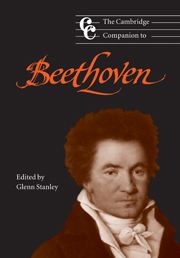Book contents
- Frontmatter
- Part I A professional portrait
- Part II Style and structure
- 4 “The spirit of Mozart from Haydn's hands”: Beethoven's musical inheritance
- 5 Phrase, period, theme
- 6 “The sense of an ending”: goal-directedness in Beethoven's music
- Part III Genres
- Part IV Reception
- Notes
- Selected further reading
- General index
- Index of Beethoven’s compositions and sketches
- Plate section
6 - “The sense of an ending”: goal-directedness in Beethoven's music
from Part II - Style and structure
Published online by Cambridge University Press: 28 September 2011
- Frontmatter
- Part I A professional portrait
- Part II Style and structure
- 4 “The spirit of Mozart from Haydn's hands”: Beethoven's musical inheritance
- 5 Phrase, period, theme
- 6 “The sense of an ending”: goal-directedness in Beethoven's music
- Part III Genres
- Part IV Reception
- Notes
- Selected further reading
- General index
- Index of Beethoven’s compositions and sketches
- Plate section
Summary
What we call the beginning is often the end
And to make an end is to make a beginning.
The end is where we start from.
(t. s. eliot, four quartets , “little gidding,” v, 1–3)Why does a piece of music end? Or rather, why does it end where it does? Webern, during the composition of his Six Bagatelles for string quartet op. 9, felt driven to a particularly uncompromising answer: “Here I had the feeling, ‘When all twelve notes have gone by, the piece is over.’” He was, admittedly, recalling his path to twelve-note composition; yet Heinrich Schenker, concerned exclusively with the structure of tonal music – to him, Webern's was a “path” that led away from music altogether – was equally clear about endings. In Free Composition he claimed that “with the arrival of Î the work is at an end. Whatever follows this can only be a reinforcement of the close – a coda – no matter what its extent or purpose may be.” There will be more to say about codas in due course; but we need immediately to distinguish Schenker's construal of “coda” from the conventional one whereby, for example, the section of music that follows the end of a sonata-form recapitulation is denominated the “coda.” A particularly clear Beethoven example is the coda to the finale of the “Appassionata” Sonata, beginning at m. 308: the double bar and new tempo indication articulate this coda especially strongly.
- Type
- Chapter
- Information
- The Cambridge Companion to Beethoven , pp. 84 - 102Publisher: Cambridge University PressPrint publication year: 2000
- 2
- Cited by



